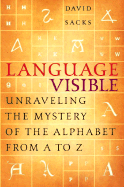Language Visible: Unraveling the Mystery of the Alphabet from a to Z

by David Sacks
ISBN: 0676974872
Post Your Opinion | | A Review of: Language Visible: Unraveling the Mystery of the Alphabet from A to Z
by A. J. LevinYou may know this Monty Python routine: a woman, her husband, and
their daughter are sitting around an English country home discussing
whether words like "caribou" and "sausage" are
tinny or woody. To a native or at least a very fluent speaker, the
sounds of words conjure up a story apart from the words themselves.
Just as well, or we'd have no poetry-and Christian Bk's poetry
volume Eunoia has shown us that each of the five English vowels has
a personality all its own. This is true of consonants as well. If
you think about it, "B", "F" and "P"
are all silly (bimbo, bum, frou-frou, Flubber, fumble, piffle,
pee-pee) compared to the grandeur of gallant, rugged "G".
Ottawa-based journalist and author David Sacks documents the
individuality of each of the twenty-six letters that form the
(English) Roman alphabet. Sacks runs over the history of the sound
and shape of the letters, following them from their origins in the
Near East, through to the Greeks, Etruscans, Romans, Medieval monks
and Gothic runes, and to their present-day appearance and cultural
significance.
Sacks is a smart writer and the premise is excellent, particularly
the promise of a fun, modern "biography" of letters-Why
is a movie "X"-rated? Why do things fit to a "T"?
What's the "E" in E=mc2? Why can you get a "D"
or an "F" but not an "E" on a test?
The execution, however, is less than overwhelming. The history of
each letter is well-researched and the book incorporates the latest
archaeological evidence. Still, you could glean much of this
information from a good dictionary such as the OED. There are no
footnotes, so while the text flows well, we have no way of
differentiating solid fact from teetering opinion.
The book is lavishly illustrated with photographs, maps, samples
of letters, drawings and the like. Still, these fireworks do not
make up for what feels like the mere duplication, from chapter to
chapter, of the original twenty-six columns (printed in the Ottawa
Citizen). These seem to have been deposited into book form without
proper adaptation to the new medium. Because a newspaper's
requirements regarding the length of pieces differ from those of a
book, common letters like "S" and "E" receive
in Saks's book no more attention than their oddball brethren
"K" and "Q". And because the columns were weekly,
much of the information, in an already hefty book, is repeated.
Adjacent chapters mention that My Fair Lady was based on Shaw's
Pygmalion. And since "I" and "J" started out
as the same letter, as did "U" and "V", much
is needlessly redundant in the four chapters.
There are many interesting facts and opinions scattered throughout
the work, but because Sacks is not a scholar in the field, he is
not compelled to justify his assertions. In one case, he posits
that the triangular Phoenician equivalent of "D" was dag
(fish) rather than daleth (door), as it is commonly believed, and
is in Modern Hebrew. His evidence comes from a recently discovered
inscription at Serrabit el-Khadem with a fish-shaped character that
follows the word ba'alat (mistress), or perhaps the words ba'al et
([the] (master). As secondary proof, Sacks tells us he's unable to
see how the letter daleth, which gave rise to delta, looks like a
door. But at this early stage, logographs were not separated fully
from letters, so it is reasonable to suppose that the inscription
was to a fish deity. Indeed, Ba'al was a synonym of Da'agon, a fish
god in the ancient Near East. Then, too, tents had more daleth-like
openings than our modern houses, and daleth doesn't look much like
a fish either.
Sacks similarly does not see why the wavy letter that stands for
"N" should have been nun (apparently meaning fish) when
in early uses it appears to have been shaped like a serpent (nahash).
But Sacks himself points out that the Phoenicians' writing came
from the priestly writing of the Egyptians, and one of the great
deities of ancient Egypt was Nu or Nun, the god of the chaotic Nile
waters, the source of Ra Himself. Indeed, the last part of the
hieroglyphic sign for Nun's name is a snake, and his wife Nunet is
often depicted as having a snake's head.
David Sacks has tried to give us an entertaining book on our script,
and with a little more care from author and publisher, this could
have become a classic. But if you print a book on letters for the
Canadian market, it would be better to spell the words la canadienne,
and not to refer to "our specifically American spelling
rules."
|